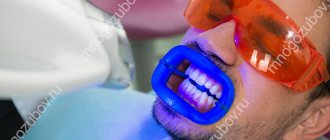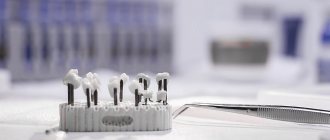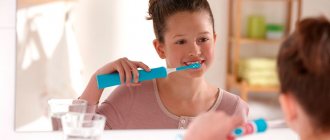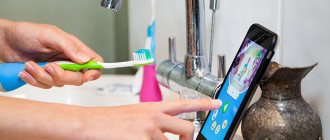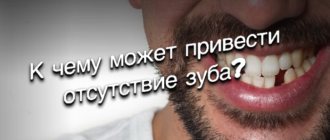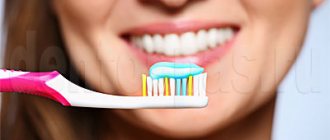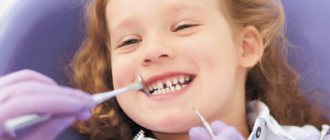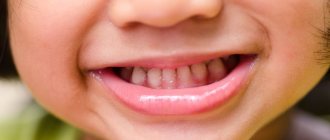A children's toothbrush is your child's main friend in the prevention and fight against dental diseases.
Many parents are sure that their child does not need a toothbrush. After all, baby teeth will soon fall out. Pediatric dentists at the A.Dent clinic say the opposite. It is with this little helper – a toothbrush – that a baby’s morning should begin. From the moment they appear, teeth need care. First, they are wiped with a terry fingertip or a cotton swab without using any paste, since the child may eat it. Later, when the number of teeth increases, you can accustom the child to a toothbrush.
The first toothbrush may have no bristles at all. There are special pimples on its head that do not injure the gums, but massage them. From the age of 6, a child can already buy a regular children's toothbrush.
When should you start oral hygiene?
Preferably from birth, and not from the moment the first tooth erupts.
Before it appears, using special devices, you can prevent childhood candidiasis (thrush); growth and reproduction of infection that causes sinusitis, tonsillitis, sore throat, meningitis. To do this, purchase a fabric fingertip. When the first tooth has erupted and from the moment until the child is able to carry out the cleaning procedure on his own, it is recommended to use a silicone fingertip. Where can caries come from in young children? Many toddlers suffer from regurgitation syndrome.
The milk in the stomach and up the esophagus into the oral cavity is already mixed with hydrochloric acid, which is part of the gastric juice. That is, the milk automatically becomes sour. And such an environment is an excellent “soil” for the proliferation of bacteria. According to statistics, in 56% of children the cause of the development of chronic sinusitis is the lack of normal oral hygiene. As soon as the first tooth emerges, start using a silicone finger guard. Vegetables and fruits, when introduced into the diet, make the environment in the oral cavity acidic. If you do not cleanse, bacteria will mercilessly penetrate the porous enamel, causing the development of inflammation and caries.
Silicone and fabric baby finger pads from the following companies are popular: Canpol babies, Pigeon, Philips Avent, Tommee Tippee. Which one to choose is up to you. The only thing that can be noted is that don’t save money, try proven companies, for example, Canpol babies.
Description
Since the baby cannot independently perform hygiene procedures, this most important function falls on the shoulders of his parents. When choosing a silicone fingertip, consider the following points:
The accessory must be completely silicone, including the bristles. This will keep the baby healthy and not damage the soft tissues of the oral cavity. It is easier for the parent to control the force of pressure on the teeth and gums.
The presence of even slightly noticeable seams on the surface of the product is not allowed. There is a huge risk of various microorganisms and bacteria harmful to health appearing at these joints.
The fingertip must be equipped with a special case where the accessory will be stored.
Peculiarities
Cloth napkins are a disposable device. Does not contain chemical, aggressive components, has a pleasant taste. But still, consult your pediatrician before use.
The silicone fingertip looks like a transparent cap. Can be used many times. The surface is covered with short tubercles.
The special feature is that you put it on your finger and cleanse it. Another ability is that the device gently removes plaque from the enamel and mucous membranes, and uses the villi to massage the gums.
Parents have different opinions on the use of silicone or rubber fingertips. For some reason, many are sure that they injure the delicate mucous membrane of the child’s mouth. But this is a misconception. First, cleanse gently, without force or pressure. Secondly, the fingertip is made of safe silicone, which prevents mechanical damage. It is also advisable to use it during teething, when the gums swell. And your pediatrician or pediatric dentist will tell you about this.
Also watch a video from Beauty Ksyu’s channel about how she uses a fingertip:
Thanks to the silicone fingertip, the following processes occur in the baby’s mouth:
- stagnation in gum tissue is eliminated;
- blood circulation in the gums and mucous membrane improves;
- gums are strengthened;
- Bleeding, swelling, and inflammation are prevented.
Massage also promotes faster and easier teething in babies.
silicone fingertip for cleaning teeth
On January 2nd we celebrated Yulka’s one year anniversary and the most difficult year of my life. I hope it gets easier.
About the physical.
The main method of movement for the past four months has been crawling. It crawls quite quickly, the cats only have time to run away. He stands up against any support, including my leg, regularly pulling off my pants. Loves to walk and even run with support from two hands. In this way, he can walk as much as he wants until the driver’s back begs for mercy. As soon as you take one hand, he stops dead in his tracks and begins to look for his hand back or grabs his leg. At the support he moves reluctantly, a few steps along the sofa at most. Loves to climb any low obstacles such as sofa cushions and me. She can’t climb onto the sofa, she’s too small, she’s not tall enough to throw her leg up.
About skills.
He ignores the lamentations of “okay, okay,” but claps with pleasure if you say “How does Yulia clap her hands?” Same thing with waving “hello-bye.” She herself waves to those standing at the threshold; if you wave back, she immediately stops. He shows few body parts and reluctantly, only on toys; for me he only shows his mouth; he doesn’t show anything at all on himself. When he hears “Give”, he makes a characteristic movement with his hand. When he hears the word “Hello,” he puts his hand to his ear. Sniffling shows a hedgehog. She started babbling a month ago, now she has dad, grandma, and mom in her arsenal (she just started talking a week ago). Of course, unconsciously, but thanks for that. He loves to read, but only two books - about Shmyak and “The Favorite Book of Kids” (you guessed it) with nursery rhymes and poems by Barto, Chukovsky, etc. The rest immediately reaches out to close it or simply turns away and crawls away. He shows no interest in the spoon; if you give him freedom in food, he will throw the spoon away and eat his hands. Therefore, I don’t give free rein to the spoon yet.
About food.
GW was curtailed in exactly one year. Before this, feeding was only in the morning, which gradually shifted first to 4 in the morning, then to 5, 6, 7, and eventually she stopped waking up for it. If he wakes up, he is satisfied with stroking and a pacifier. Eats 4 times a day, regularly, a lot. She has already introduced all the main types of foods, eats everything, does not refuse anything. Favorites include porridge with fruit and bread with cookies. I give him the mixture at night and he drinks it with pleasure.
About teeth.
The first appeared at 9.5 months, at the moment there are 4 of them and two more on top. There were no special hysterics about my teeth, but as usual I attribute any bad mood to my teeth. I’m trying to get used to brushing my teeth, first with a silicone fingertip, and now I’ve already bought a brush. In the mornings he sits next to me on the washing machine and moves something in his mouth.
About sleep.
We are in a difficult period of transition from two dreams to one. Two are definitely too many, but one sleep is definitely not enough. A day like this, a day like that. Because of this, the routine has become very loose; we wake up at 7 and go to bed at 10, which we don’t like at all. But there is nothing to be done for now. The first nap is sleeping on the loggia in a stroller, the second nap is short next to the parent on the bed. He also sleeps at night on the bed with his parent, then we transfer him to the crib. Once again I promise myself to start putting myself to bed... On December 17th, a miracle happened - sleeping without waking up all night. Just as I fell asleep at 21:00, I just woke up at 8:30. There have been no more such gifts yet. During the night he usually wakes up three or four times, gets a pacifier, turns over on his side and continues to sleep.
About performance characteristics.
She turned one year old with a weight of exactly 8 kilograms and a height of 68 cm. She looks very small, although quite plump. She successfully walks in size 62 overalls, which I bought for her at the time when she was discharged from the maternity hospital (ha ha). We pass the commission every year, so far there are no complaints.
About different things.
She still loves cats, she even squeaks. Moreover, any kind of cats - he rejoices at the screensaver on his laptop, a video with a kitten on Instagram. Naturally he pursues his own people, trying to pet them as best he can. At the end of the year I got sick for the first time with fever, conjunctivitis and other joys of the flu. He drives terribly in the car, I really hope that changing the car seat will help, otherwise at least stay at home. I began to ride better in a stroller, with virtually no disturbances. He still doesn’t like sharp sounds, and he cries from musical toys.
Instructions for use
Children under 6 months:
- Wrap the cloth around your little finger.
- Clean not only your gums, but also the inside of your cheeks and tongue.
- Using circular movements, first treat the lower gum, then the upper.
- The cleansing time depends on how much the child likes the procedure. Do not overdo it so as not to cause disgust.
- For newborns whose teeth have not yet erupted, it is advisable to cleanse them after each feeding, especially if the baby constantly spits up after eating.
Children from 6 months to 1 year:
- Place the silicone fingertip on your index finger or little finger.
- Brush your teeth in a circular, sweeping motion, without pressing. Start from the gums to the top.
- Massage the gums where teeth have not yet erupted for 1 minute.
- Use your example to show your child how to rinse his mouth with water. Over time, the baby will begin to repeat this procedure after you.
Rules for using a children's toothbrush
Storage
You should use a dry glass to store your toothbrush. You need to place the brush in it with the handle down. To protect the brush head from germs, the bristles are lathered with baby soap, which is washed off before use. Storage cases are convenient to use when traveling, but it is not advisable to use them at home, since bacteria accumulate in them.
First use of the brush
Before a children's toothbrush for the first time, it must be rinsed, but not in boiling water, otherwise it will melt and become unusable.
Replacing your toothbrush
A child's toothbrush, like an adult's, needs to be changed every 3 months. After all, even careful processing does not remove all food debris, and therefore harmful bacteria. In pediatric dentistry, they believe that you need to change your brush at the beginning of each season. Pediatricians are of the opinion that changing a child’s toothbrush must be carried out after any illness suffered by the child.
Dr. Zubastik recommends
There is an opinion among parents that there is no need to brush baby teeth. What difference does it make whether they have caries or not? After all, they will fall out anyway.
Caries is an inflammatory process caused by pathogenic microorganisms. Infection through microcracks in the mucous membrane can enter the bloodstream and cause various pathologies - sinusitis, tonsillitis, tonsillitis, meningitis. Therefore, I recommend cleaning the baby’s mouth before the first teeth erupt. Thus, you will prevent the development of caries, periodontitis, chronic sinusitis, and tonsillitis.
Tags: fingertip, brushing teeth
About the author: Dr. Zubastik
Typically, a toothache begins to subside on the way to the clinic and finally goes away after 10 minutes of sitting in line to see the dentist.
- Related Posts
- Can tartar fall off on its own?
- What instruments are used to clean teeth?
- Who can benefit from vector teeth cleaning?
« Previous entry
Rules for choosing a children's toothbrush
Handle length
While parents are brushing the child’s teeth, in order for the brush to be comfortable to hold, its handle should be elongated. When your baby starts brushing his teeth himself, a brush with a short and thick handle will be more convenient to use.
Brush shape and bristle composition
The head of a children's toothbrush should be small and slightly rounded in shape to make it easier to clean. It is better to refrain from buying a brush with natural bristles, since it is natural materials that most often harbor bacteria. The optimal height of the bristles is 1.1 cm. The ideal option is a head with bristles of different heights. It makes it easier to remove plaque.
Corrugated neck
You should also think about the safety of the baby. A brush with a “corrugated” neck will help prevent gum injury. This form of connection regulates the force of pressure of the toothbrush on the gums and teeth.
Brush color
Of course, last but not least, you should pay attention to the colors. You can attract a toddler to a three-minute “execution,” especially twice a day, only with bright brushes with images of funny animals or favorite cartoon characters.
Main characteristics.
When choosing a brush for your baby, first of all you need to pay attention to the following: - a comfortable short handle - it will be much more convenient for your baby to control the brush; - soft bristles - tooth enamel is still too delicate and susceptible to abrasion, which is why the use of adult brushes is strictly contraindicated; - small head and cleaning surface - otherwise it will affect the quality of cleaning.
There is a very large selection of children's electric brushes here.

